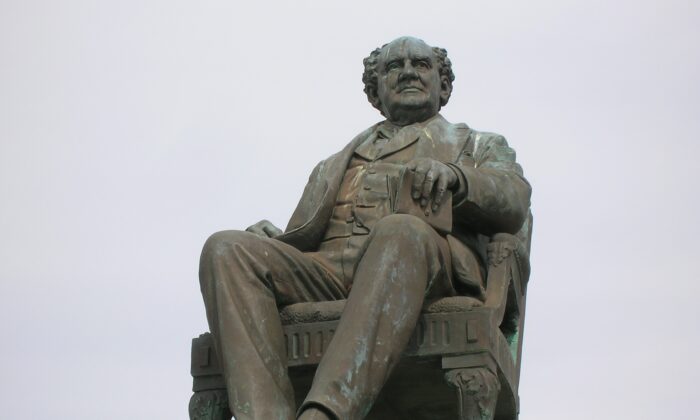Popcorn and Inspiration: ‘Thunderheart’: Acknowledging Spiritual Reality
Phineas Taylor (“P.T.”) Barnum (1810–1891), of Barnum & Bailey Circus fame, almost certainly never said “there’s a sucker born every minute.” He did, however, say “I don’t believe in duping the public, but I believe in first attracting and then pleasing them.”
Robert Wilson’s biography “Barnum: An American Life” shows his subject often walking a fine line between these points of view on his way to becoming one of the most distinctive individuals of the 19th century. Best remembered for his showmanship, Barnum was also an author, publisher, lecturer, philanthropist, and politician.
The Showman
Barnum, Wilson says, always targeted his entertainment toward the middle class, but never regarded his audiences as people to be taken advantage of. He saw them as hardworking souls who deserved unusual and wondrous entertainment, all in a family-friendly environment. If an exhibition, such as the display of the remains of a so-called mermaid, wasn’t quite what it seemed, then as long as the audience enjoyed the experience, what was the harm?
Born in Bethel, Connecticut, into what he would later call “an atmosphere of merriment,” Barnum proved himself adept at mathematics and linguistics. Though he hated hard work, he quickly learned that he enjoyed the feeling of independence that money gave him. He also realized he was happiest when working for himself.
Barnum got an early understanding of the power of publicity when he became involved in running lotteries, an unregulated and wildly popular practice at the time. His advertising in papers boosted sales for his contests above those of his competitors. Though, as Wilson also notes, Barnum often had a double-edged relationship with the press. He battled with those critics and reviewers who saw his shows as exploitative and fake, all while their papers accepted his paid advertising.
Wilson makes a point to explore Barnum’s actions in the context of his era. Barnum first got involved in show business in 1835 when he took over an act featuring a blind African-American woman, who was supposedly 161 years of age and present at George Washington’s birth. While such an exhibition would be completely unacceptable today, it was a perfect fit for the times, when news took days to travel from one location to the next and when people were hungry for new attractions and experiences.
Barnum would spend the next several years touring with various acts, until he purchased Scudder’s American Museum in lower New York City in 1842. The building, a large storehouse of artifacts and devoted to lectures and presentations of both the educational and entertaining variety, would become Barnum’s home base for years. He acquired as many new objects and acts as possible for his museum.
Much of the book recounts Barnum’s show business triumphs. There are entire chapters dealing with such people as “General” Tom Thumb (Charles Stratton, a young boy with dwarfism) and the Swedish singer Jenny Lind, as well as the extensive promotional campaigns Barnum created for each.
The work also explores Barnum’s late-in-life partnership with James A. Bailey. Bailey and his partners actually bested Barnum in terms of popularity with their own circus acts, leading Barnum to agree to join forces with them.
 Robert Wilson’s biography illuminates one of the most distinctive individuals of the 19th century.
Robert Wilson’s biography illuminates one of the most distinctive individuals of the 19th century.The Man
Just as interesting is how Wilson shows Barnum to be someone who evolved personally. Growing up, he seemed to accept slavery, or at least turned a blind eye to it. However, by 1855 he had become a strong supporter of abolition. His disdain for those who refused to support the Union cause during the Civil War spurred him to get involved in politics.
Barnum served as a member of the Connecticut legislature and later the mayor of Bridgeport. He unsuccessfully ran for Congress and was considered at points to be a possible presidential candidate.
He supported several movements, including the temperance movement, eventually abstaining from any type of alcohol and lecturing frequently on the subject.
While Barnum was an avid letter writer and correspondent, he spoke very little about his family or any personal or financial tragedies he suffered. He was widowed once and married twice, and had four children, two of which he outlived. His pursuits often required him to be away from his family for more than a year at a time, which Wilson puts down to Barnum’s restlessness and need to immerse himself in new projects.
Well-researched—with quite an extensive bibliography and a footnote section of interesting information that didn’t make it into the book itself—”Barnum: An American Life” is straightforward yet deeply involving and makes for a fascinating read.
‘Barnum: An American Life’
Robert Wilson
Simon & Schuster
352 pages
Judd Hollander is a reviewer for stagebuzz.com and a member of the Drama Desk and Outer Critics Circle.
Focus News: Book Review: ‘Barnum: An American Life’
Pompeo Declares Hong Kong No Longer Autonomous From China, Slams Beijing’s Proposed Security Law
